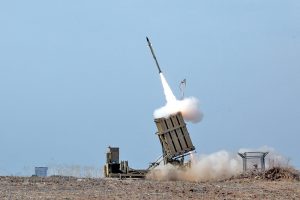The Iron Dome Aerial Defence System:

The Iron Dome aerial defence system intercepted a Hamas Unmanned Aerial Vehicle (UAV) that crossed from Gaza into Israel, Israeli Defence Forces (IDF) said on social media.
- Iron Dome is a multi-mission system capable of intercepting rockets, artillery, mortars and Precision Guided Munitions like very short-range air defence (V-SHORAD) systems as well as aircraft, helicopters and Unmanned Aerial Vehicles (UAV) over short ranges of up to 70 km.
- It is an all-weather system and can engage multiple targets simultaneously and be deployed over land and sea.
- Iron Dome is manufactured by Rafael Advanced Defence Systems and has been in service with the Israeli Air Force since 2011.
- The radar system was developed by Elta.
- Its development was prompted after a series of rocket attacks on Israel by Hezbollah and Hamas in the 2000s.
- An Iron Dome battery consists of a battle management control unit, detection and tracking radar and a firing unit of three vertical launchers, with 20 interceptor missiles each.
- The interceptor missile uses a proximity fuse to detonate the target warhead in the air.
- The Iron Dome is deployed in a layered defence along with David’s Sling and Arrow missile defence system which are designed for medium- and long-range threats.
- The I-DOME is the mobile variant with all components on a single truck and C-DOME is the naval version for deployment on ships.
- One of the system’s important advantages is its ability to identify the anticipated point of impact of the threatening rocket, to calculate whether it will fall in a built-up area or not, and to decide on this basis whether or not to engage it.
- This prevents unnecessary interception of rockets that will fall in open areas and thus not cause damage, the paper states. The system has intercepted thousands of rockets so far and, according to Rafael, its success rate is over 90%.




